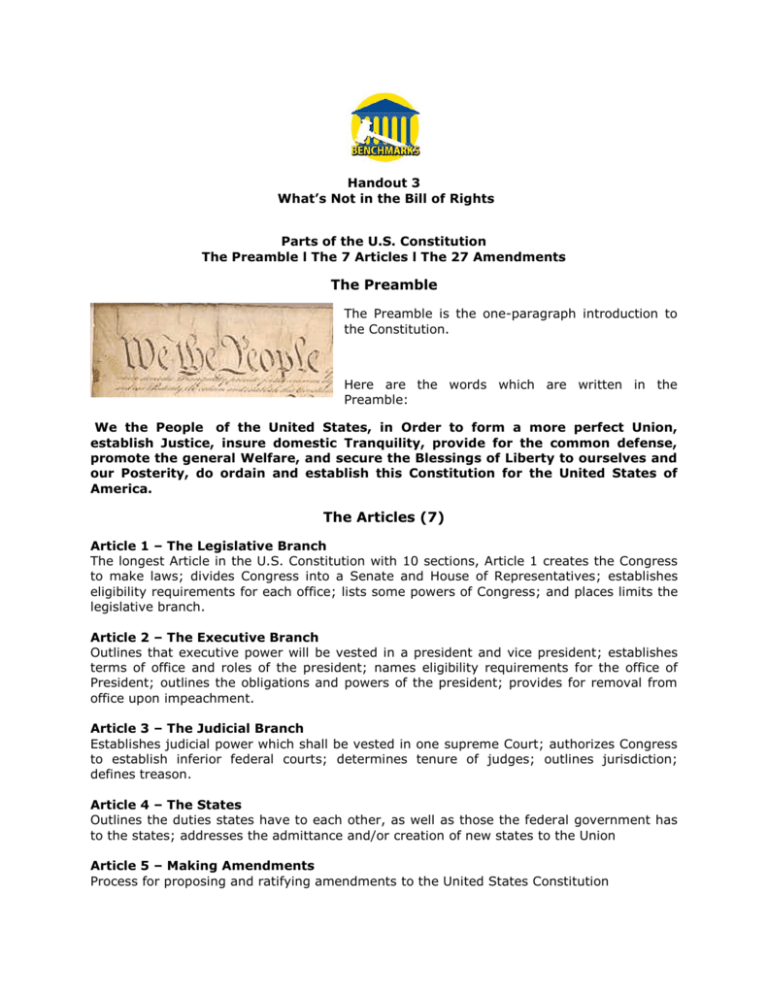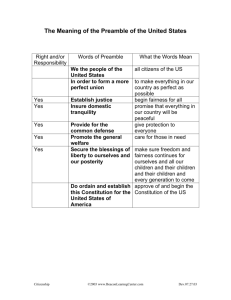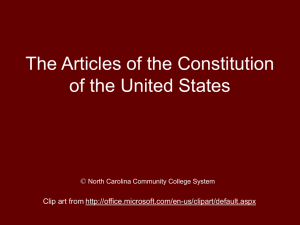The Preamble The Articles (7)
advertisement

Handout 3 What’s Not in the Bill of Rights Parts of the U.S. Constitution The Preamble l The 7 Articles l The 27 Amendments The Preamble The Preamble is the one-paragraph introduction to the Constitution. Here are the words which are written in the Preamble: We the People of the United States, in Order to form a more perfect Union, establish Justice, insure domestic Tranquility, provide for the common defense, promote the general Welfare, and secure the Blessings of Liberty to ourselves and our Posterity, do ordain and establish this Constitution for the United States of America. The Articles (7) Article 1 – The Legislative Branch The longest Article in the U.S. Constitution with 10 sections, Article 1 creates the Congress to make laws; divides Congress into a Senate and House of Representatives; establishes eligibility requirements for each office; lists some powers of Congress; and places limits the legislative branch. Article 2 – The Executive Branch Outlines that executive power will be vested in a president and vice president; establishes terms of office and roles of the president; names eligibility requirements for the office of President; outlines the obligations and powers of the president; provides for removal from office upon impeachment. Article 3 – The Judicial Branch Establishes judicial power which shall be vested in one supreme Court; authorizes Congress to establish inferior federal courts; determines tenure of judges; outlines jurisdiction; defines treason. Article 4 – The States Outlines the duties states have to each other, as well as those the federal government has to the states; addresses the admittance and/or creation of new states to the Union Article 5 – Making Amendments Process for proposing and ratifying amendments to the United States Constitution Article 6 – Supreme Law of the Land Supremacy Clause; the Constitution is the highest law of the land Article 7 – Ratification The Constitution was officially established when nine out of 13 states approved the document. The 27 Amendments 1. Freedom of religion, speech, press, assembly, petition 2. Right to bear arms 3 Quartering of troops 4. Search and seizure 5. Due process, double jeopardy, self-incrimination 6. Speedy and public trial by impartial jury; right to be informed of the nature and cause of the accusation; right to be confronted with witnesses against the accused; right to counsel 7. Civil trials; Common law suits 8. Excess bail or fines, cruel and unusual punishment 9. Rights named in the U.S. Constitution do not negate rights not listed 10. Powers reserved to states, or the people 11. Lawsuits against a state 12. Election of president and vice president 13. Abolition of slavery 14 Due process, equal protection, privileges of citizens 15. Voting rights not to be denied to citizens because of race 16. Federal income tax 17. Composition of the U.S. Senate and Election of U.S. Senators 18. Prohibition 19. Voting rights not to be denied to citizens on account of sex/gender 20. Commencement of Presidential and Congressional terms 21. Repeal of prohibition (18th Amendment) 22. No person shall be elected to the office of President more than twice; President limited to two terms (not to exceed a total of ten years in office) 23. Presidential vote (electors) for the District of Columbia 24. Abolition of poll tax in federal elections 25. Presidential succession 26. Voting rights are not to be denied to citizens 18 years of age or older 27. Congressional compensation and pay raises *Any variations in spelling of certain words are based on the original spelling found in the U.S. Constitution.






